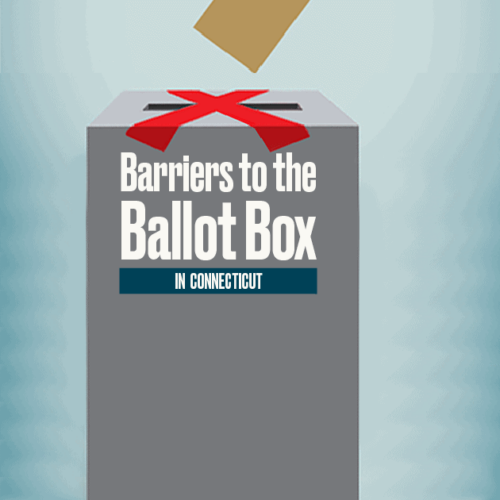Introduction
Outside of the South, deep blue and deeply segregated Connecticut has some of the most restrictive voting laws in the country. Long lines on Election Day disproportionately affect Black and Latino voters.
It’s one of a handful of states that does not allow early voting. It doesn’t allow no-excuse absentee balloting. And it doesn’t count absentee ballots that arrive after Election Day, no matter when they are postmarked.
Sign up for The Moment newsletter
Our CEO Susan Smith Richardson guides you through conversations and context on race and inequality.
“It’s embarrassing,” said Gabe Rosenberg, communications director for Connecticut Secretary of the State Denise Merrill, who has pushed for an amendment to the state constitution that would allow early voting and other reforms.
Here’s a look at some of the most significant barriers to voting rights and access in the state:
Absentee and early voting
Connecticut passed special legislation this year allowing absentee ballots to be cast due to general concerns about COVID-19, and the state has mailed absentee ballot applications to all registered voters. As of Friday, Rosenberg said 475,402 absentee ballot requests had been processed with a month to go before the election, compared to 126,948 in all of 2016.
But the change is temporary. Connecticut’s state constitution allows absentee ballots due to “absence from the city or town of which they are inhabitants or because of sickness, or physical disability or because the tenets of their religion forbid secular activity.” Voters narrowly rejected a constitutional amendment that would have made it easier to obtain absentee ballots in 2014, but which included language that advocates said was confusing. Last year, Republicans in the General Assembly blocked an effort that would have sent a constitutional amendment allowing early voting to a statewide referendum this November.
And unlike states where absentee ballots must be postmarked by Election Day and arrive by a specified later date to be counted, in Connecticut, ballots must be received by local registrars before polls close at 8 p.m. that day or they’ll be thrown out.
It’s a concern in a state where mail for most-populous Fairfield County is routed through White Plains, New York, and in a year marked by worries about the reliability of the U.S. Postal Service under a new postmaster appointed by President Donald Trump.
The Secretary of the State’s office has deployed 250 secure drop boxes to receive absentee ballots, one for each of Connecticut’s municipalities, and more than one for the state’s 31 biggest cities and towns, Rosenberg said. He called it “a convenient, contact-less way to deliver your absentee ballot” without having to worry about mail delays.
Election Day troubles
Connecticut does not have county or regional government. Its 169 cities and towns operate independently, and their interpretation and execution of state law can vary widely.
While Connecticut law says that the Secretary of the State’s office interprets election law, sometimes it’s a process of negotiation, cajoling and reminding independent city and town clerks and local registrars of what the state considers to be best practices.
One town initially refused delivery of the secure drop box this year, for example, and another insisted on placing it inside town hall, undermining the idea of an outdoor location safe from COVID-19 and available at all times.
In 2016 and 2018, problems on Election Day in some of the state’s biggest cities led to long lines and some voters going home without casting a ballot.
In New Haven, one of those challenges has been a rush of last-minute attempts by Yale University students to register to vote when there are major elections. In 2018, Rosenberg said, New Haven only had two computers set up at a single location to accommodate Election Day registrations. “It’s not a surprising outcome that there’d be super-long lines,” he said.
In 2014, a local registrar in Hartford failed to deliver voting lists to polling places in time for the 6 a.m. start of voting.
The Secretary of the State’s office has argued that less-restrictive absentee ballot rules and early voting would help avoid such problems. The state has also adopted mandatory training of local election officials.
Voter ID
Connecticut is one of 36 states with a law allowing local officials to demand ID from voters before their ballot is cast, a practice proven to disproportionately prevent people of color and the poor from voting.
Unlike some states that require photo ID, or have strict limits on what forms are acceptable, Connecticut offers voters wide leeway. A utility bill, Social Security card or just about anything that has the voter’s name and signature on it are acceptable if the voter doesn’t have a photo ID such as a driver’s license. If the voter doesn’t have that, the person can sign a sworn affidavit and vote, or cast a provisional ballot.
Disinformation
Worried that the Trump campaign and Russian disinformation campaigns will sow doubt about the integrity of the election should it take a long time to count votes this November, the Connecticut General Assembly passed a bill in special session this fall allowing local officials to start processing absentee ballots the Friday before the election so total results can be known as soon as possible after the polls close Nov. 3.
Merrill’s office has also set up an online system allowing voters to track the status of their absentee ballot and a reporting system for monitoring online disinformation about the election.
Correction: Oct. 7, 2020, 3:30: p.m.: An earlier version of this story incorrectly reported that the Connecticut General Assembly passed a bill in special session this fall allowing local officials to start counting absentee ballots the Friday before the election. It has been changed to say that they’ll be allowed to start processing absentee ballots, a process that involves verification with voting rolls. No actual vote counting takes place in Connecticut until Election Day.
Read more in Money and Democracy
US Polling Places
Court battles test Arizona’s long history of voter suppression
Republican restrictions affect Latino and Native American voters after the Supreme Court’s weakening of the Voting Rights Act.
US Polling Places
In Tennessee, trying to help voters could get you charged with a crime
Court fights mean more people can vote by mail to avoid coronavirus exposure. But state law targets voter-outreach efforts.


Join the conversation
Show Comments